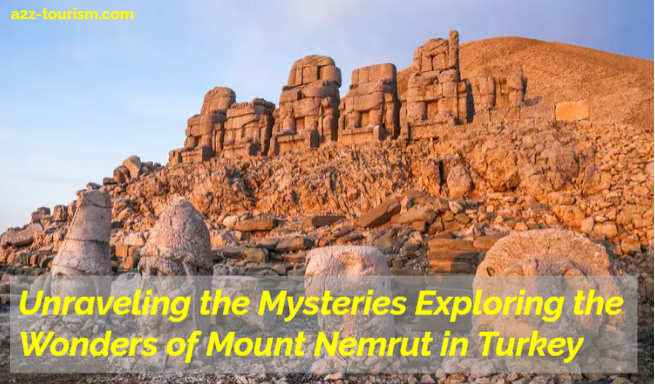Mount Nemrut, positioned in southeastern Turkey, is a witching destination that combines elderly history, stirring geographies, and monumental statues. This majestic mountain has attracted callers from around the sphere who seek to unravel its mystifications and attest to its amazement-inspiring beauty. In this composition, we will embark on a virtual trip to Mount Nemrut, researching the literal denotation of the point, the intricate artificer of its colossal statues, and the alluring appeal of its natural surroundings. border us as we claw into the marvels of Mount Nemrut and discover the beguiling stories that have adapted this peculiar archaeological locality.
literal Background
To truly appreciate the significance of Mount Nemrut, it’s essential to claw into its literal environment. erected during the 1st century BC by King Antiochus I of the Kingdom of Commagene, the mountain served as his final resting place and a grand monument to his reign. Antiochus I sought to blend Greek and Persian societies, and his grave atop Mount Nemrut showcases this emulsion in its armature and puppets. The point stayed largely unlearned until its detection in the 19th century, sparking regenerated interest in this archaeological pride.
The Marvelous Statues
The most extraordinary point of Mount Nemrut lies in the colossal statues that dominate its peak. These statues, standing at an emotional height of over 9 measures, depict colorful divinities and mythological numbers, including Greek gods, Persian divinities, and members of the Commagene royal family. The scrupulous artificer and attention to detail displayed in these puppets continue to amaze callers. The statues are strategically arranged, facing eastward to chat the turning out of the sun during daylight and evening, creating a stirring raree-show.
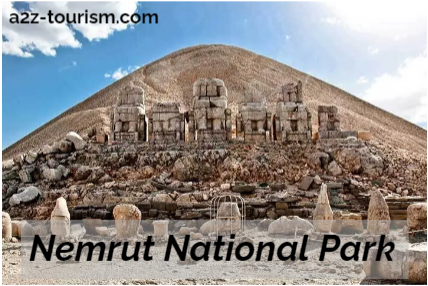
Nemrut National Park
Mount Nemrut and its girding areas were declared a public demesne in 1988, icing the preservation of its literal and natural prodigies. The Nemrut National Park encompasses a vast area, giving callers a chance to explore not only the hump and its statues but also the distinct leafage and fauna that thrive in this region. From rare species of orchids to fugitive mountain scapegoats, the premise is a harborage for nature nuts and wildlife suckers.
Artistic Significance
Mount Nemrut holds immense artistic and religious significance, serving as a testament to the ancient beliefs and societies that formerly thrived in the region. The where represents a euphonic mix of Greek, Persian, and indigenous societies, showcasing the artistic diversity that one time was in the Kingdom of Commagene. Mount Nemrut’s statues and graves give precious perceptivity into the religious and political testaments of the time, fashioning it a precious archaeological point for experimenters and annalists.
Passing Mount Nemrut
Visiting Mount Nemrut offers a unique and indelible experience. The expedition to the mountain’s peak involves a moderate hike, allowing callers to engage themselves in the natural beauty of the girding geography. As they lift, the expectance builds, capping in the stirring sight of the majestic statues silhouetted against the sky. Watching the daylight or evening from this edge point is a true admiration- an inspiring moment, etching recollections that last a continuance.
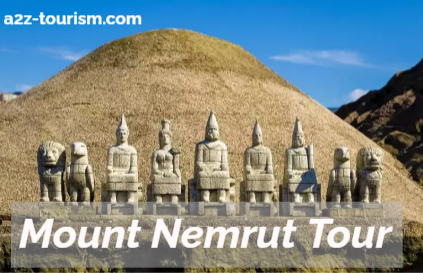
Mount Nemrut Tour
For those planning a trip to Mount Nemrut, several stint drivers offer guided excursions to ensure a comprehensive and enriching experience. These tenures generally include transportation, knowledgeable attendants, and visits to other literal spots similar to Arsameia and the ancient megacity of Zeugma. With the backing of educated attendants, callers can gain deeper perceptivity into the literal and artistic significance of Mount Nemrut and its surroundings.
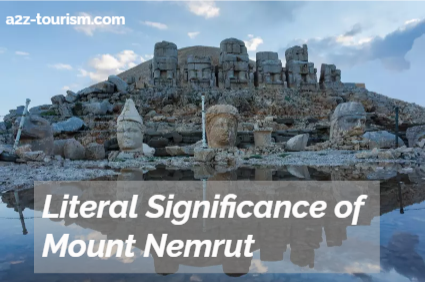
Literal Significance of Mount Nemrut
The Kingdom of Commagene
Mount Nemrut is nearly associated with the ancient Kingdom of Commagene, which flourished from the 1st century BC to the 1st century announcement. Established by King Mithridates I Callinicus, this area was strategically located at the crossroads of major trade routes. The autocrats of Commagene were known for their unique mix of Greek and Persian influences, and it was King Antiochus I Theos who ordered the construction of the monumental statues atop Mount Nemrut.
The Commagene Royal sepultures
At the peak of Mount Nemrut, callers can witness the remnants of the Commagene Royal sepultures, which were intricately sculpted and adorned with colossal statues. The grave of King Antiochus I Theos stands at the center, girdled by statues of colorful divinities, including Apollo, Zeus, Hercules, and Antiochus himself. These statues were allowed to showcase the godly lineage of the Commagene sovereigns and their jam-packed connections to both Greek and Persian divinities.
Detection and Excavation
Mount Nemrut and its monumental statues were largely forgotten for centuries until their detection in 1881 by a German mastermind named Karl Sester. Excavations in the mid-20th century revealed the true extent of the point’s majesty and literal significance. moment, Mount Nemrut is honored as a UNESCO World Heritage Site and attracts callers from around the globe.
Mythological Connections
The Gods of Nemrut
The statues atop Mount Nemrut represent an emulsion of Greek and Persian myths. The colossal numbers of gods and autocrats were deposited in a way that represented a godly council. Antiochus I Theos, the king who commissioned these statues, believed that he was an assignee of Apollo and sought to solidify his godly status through this grand display of power and piety. The statues’ arrangement corresponds to the daylight and evening, emphasizing the king’s connection to the Elysian realm.
The Legend of Tantalus
According to Greek tradition, Mount Nemrut is associated with the tale of Tantalus, a mortal who offended the gods. As a discipline, he was doomed to an eternity of thirst and hunger in the demiworld. The mountain’s name” Nemrut” is believed to be deduced from the Greek word” neos mourtos,” meaning” recently dead,” suggesting the mythological connection and the mountain’s air of riddle.
Reaching Mount Nemrut
Transportation Options
To reach Mount Nemrut, the nearest major megacity is Malatya, which is accessible by air, rail, and road. From Malatya, callers can continue their trip to Mount Nemrut by road. The mount is located in the Adiyaman fiefdom, and the final leg of the passage involves a carriageway through the fascinating village of Karadut. Original stint drivers and attendants are available to help callers organize their trips and icing smooth trip expertise.
Hiking openings
For audacious souls, hiking to the peak of Mount Nemrut offers a unique and satisfying experience. Several hiking trails lead to the top, allowing trippers to immerse themselves in the natural beauty of the girding geography. It’s judicious to embark on the hike accompanied by a knowledgeable companion who can give perceptivity into the history, foliage, and fauna of the region.
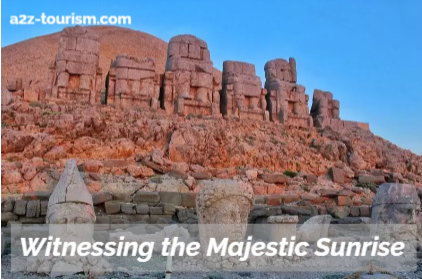
Witnessing the Majestic Sunrise
The Magical Sunrise Experience
One of the utmost admiration-inspiring moments at Mount Nemrut is witnessing the daylight from its peak. As the first shafts of the sun break through the welkin, they cast a golden gleam on the monumental statues, creating a surreal and mystical ambiance. This magnificent extravaganza attracts numerous callers who constellate at the peak before dawn, eagerly awaiting the stirring expo of nature’s enchantress.
Practical Considerations
To completely enjoy the daylight experience, it’s recommended to plan a stay at the nearby vill of Karadut or book lodgment at the base of Mount Nemrut. This ensures an early launch and a comfortable edge point to substantiate the daylight. It’s essential to dress warmly, as the mountain can be chilly, indeed during the summer months. also, carrying a flashlight or headlamp is judicious, as the path to the peak may be dimly lit.
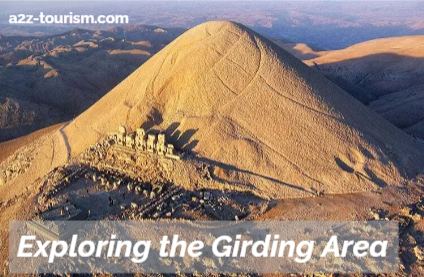
Exploring the Girding Area
Near lodestones
Beyond the splendor of Mount Nemrut itself, the girding area offers fresh lodestones worth exploring. The ancient megacity of Arsameia, located roughly 20 kilometers( 12 long hauls) from Mount Nemrut, features gemstone reliefs, eulogies, and a ground believed to have been erected by King Mithridates I. Another notable point is the Cendere Bridge, an emotional Roman ground gauging the Cendere Stream.
Cultural gests
The region girding Mount Nemrut is rich in artistic heritage. Callers can immerse themselves in the original customs, traditions, and cookery by interacting with the friendly townies in Karadut and bordering communities. Testing traditional dishes and attending original carnivals give an occasion to gain a deeper understanding of the area’s artistic fabric.
Geographical Environment and Significance
Mount Nemrut is positioned in the Taurus Mountains, within the Adıyaman fiefdom of southeastern Turkey. Standing at an elevation of 2,134 measures( 7,001 bases), it dominates the girding geography and offers panoramic views of the region. The mountain’s locus played a pivotal part in its literal significance, as it served as a representational convocation point for other societies and lifestyles.
literal Background
Commemorating King Antiochus I
The most famed point of Mount Nemrut is the collection of colossal statues that beautify its peak. These statues were commissioned by King Antiochus I of the Commagene Kingdom, who ruled from 70 to 36 BCE. Antiochus I breathed a visionary conduit who sought to establish a lasting birthright by incorporating Greek and Persian lifestyles in his area. Mount Nemrut came to a sacred point upon which he erected a funerary sanctuary known as the” Hierotheseion” or” House of the Gods,” where he’d be buried alongside the divinities he deified.
The Divinities and Eulogies
The statues at Mount Nemrut represent an emulsion of Greek, Persian, and Armenian religious and artistic traditions. The most prominent statues are those of Apollo, Zeus, Tyche, and Heracles, each seated on thrones and measuring roughly 8 to 10 measures( 26 to 33 bases) in height. These statues were intricately sculpted, with exquisite attention to detail, and were firstly adorned with hats and garments. Eulogies set up on the point exfoliate light on the religious beliefs and political bournes of King Antiochus.
Cultural Significance and UNESCO World Heritage Site
Mount Nemrut was designated as a UNESCO World Heritage Site in 1987, fetching its outstanding universal value. The emplacement is a testament to the artistic exchange and syncretism that took place during the Hellenistic period. It serves as a ground between diverse societies, pressing the interconnectedness of ancient societies and their cultural countenances.
Cultural sensations
Puppets and Hierarchical Arrangement
The monumental puppets at Mount Nemrut are a testament to the cultural skill and artificer of the ancient world. The statues were precisely deposited in a hierarchical arrangement, with the larger statues placed at the center and the lower statues bordering them. This arrangement represented the godly scale, with King Antiochus I deposited as an equal among the gods.
Iconography and Symbolism
The iconography of the statues reflects the religious beliefs and artistic motifs current during the Hellenistic period. Apollo, the Greek god of the sun, music, and vaticination, is depicted with a radiant crown and a lyre. Zeus, the king of the gods, is shown with a flowing beard and a thunderbolt in his hand. Tyche, the goddess of fortune, is portrayed with a tempera crown and a cornucopia. Heracles, the fabulous idol, is depicted with a captain’s skin and a club.
Astronomical Alignment
One of the most interesting aspects of Mount Nemrut is its astronomical alignment. The statues are deposited in such a way that during the daylight and evening on specific dates, the heads of the statues cast long murk that align with the bodies. This miracle has fascinated archaeologists and astronomers likewise, adding a fresh subcaste of riddle and wonder to the point.
Religious and Cultural Influences
Influence of Zoroastrianism
Mount Nemrut’s position in the ancient Kingdom of Commagene placed it at the crossroads of different religious traditions. Zoroastrianism, an elderly Iranian faith, had a suggestive influence on the devotional practices of the field. The statues at Mount Nemrut incorporate rudiments of Zoroastrian iconography, similar to the winged fragment emblematizing Ahura Mazda, the supreme god of Zoroastrianism.
Armenian Connections
During the reign of King Antiochus I, the Kingdom of Commagene had close ties with the neighboring Kingdom of Armenia. Mount Nemrut’s literal and artistic significance extends to Armenia, as the point is believed to have served as a place of deification for Armenian tycoons and patricians. The Armenian influence can be seen in the eulogies and architectural rudiments set up at the point.
Earthquake and Preservation sweats
Over the centuries, Mount Nemrut has faced natural and mortal-convince challenges. The demesne is inclined to quakes, and several temblors have damaged the statues and the compassing edifices. also, mortal exercise, similar to marauding and vandalization, has posed pitfalls to the preservation of the point. still, combined sweats have been made to cover and conserve Mount Nemrut. Restoration systems have been accepted to stabilize the statues and help further deterioration. preservation brigades work diligently to cover the point and apply measures to ward its artistic heritage for coming originations.
Conclusion
Mount Nemrut in Turkey is an emphatic point that combines ancient art, literal significance, and stirring natural beauty. The colossal statues deputed by King Antiochus I and their intricate busts showcase the cultural brilliance of the Hellenistic period. The point’s emulsion of Greek, Persian, and Armenian influences reflects the artistic exchange and syncretism of the time. also, Mount Nemrut’s panoramic views and amazing geographies make it a witching destination for nature suckers. Conserving this artistic heritage is pivotal, and proceeding restoration sweats aim to cover the statues for unborn generations to appreciate. A visit to Mount Nemrut offers a unique occasion to witness the nobility of elderly art, claw into history, and be charmed by the splendor of nature.
Mount Nemrut stands as a testament to the majesty and cultural achievements of the ancient world. Its colossal statues, rich literal significance, and stirring position make it a must-visit destination in Turkey. The point’s emulsion of artistic influences and its astronomical alignment add an element of wonder and riddles. keeping up Mount Nemrut is consummate to defending this inestimable heritage. By visiting, individualities can’t only respect the ancient art but also contribute to the conservation sweat. Mount Nemrut offers a trip through time, where callers can couple with the history, accumulate the intricate artificer, and phenomenon at the congenital beauty that surrounds this exceptional archaeological locus.
FAQs
Why is Mount Nemrut a big name?
Mount Nemrut is notorious for its colossal statues and magnific grave- sanctuaries. It’s a UNESCO World Heritage Site and attracts callers and history suckers from all over the world.
What can be set up at Mount Nemrut?
At Mount Nemrut, you can find a large gravestone sundeck adorned with statues of divinities and mythological numbers. The most notable features include the massive statues of King Antiochus I, two Napoleons, two eagles, and colorful Greek, Armenian, and Persian gods. also, there’s a royal grave believed to be the burial point of King Antiochus.
Where is Mount Nemrut located?
Mount Nemrut is located in southeastern Turkey, specifically in the Adıyaman Province. It’s positioned in the eastern Taurus mountain range and stands at an elevation of around 2,150 measures( 7,050 bases) above ocean position.
What’s the denotation of Mount Nemrut?
Mount Nemrut holds great literal and artistic denotation. It represents the birthright of King Antiochus I Theos of Commagene and his unique mix of Greek, Armenian, and Persian sways. The place provides perception into the senior lifestyle of Commagene and showcases a catchy cultural handwork.
What’s the closest megacity to Mount Nemrut?
The closest megacity to Mount Nemrut is Adıyaman. It’s roughly 86 kilometers( 53 long hauls) down from the mountain and serves as an accessible base for callers exploring the area.
Why is it bellowed Mount Nemrut?
Mount Nemrut is believed to be named after King Antiochus I Theos of Commagene, who ruled the region around 62 BC. The mountain served as the point of his grave- sanctuary and the grand statues erected in his honor.

